Flash market leader Samsung excelled itself at the FMS 2022 event this week, showing a near blizzard of new products: a petabyte-scale SSD, a memory-semantic SSD, a SmartSSD, and SSD telemetry plus general availability of a PCIe 5 SSD and a 24GB SAS SSD and CXL DRAM. It had a fairly crowded booth at the event and we went around, iPhone camera in hand, and snapped everything that looked interesting.
There’s a lot to cover here so get yourself a coffee and set ten minutes aside to read it.
We’ll start with a statement from Jin-Hyeok Choi, EVP of Memory Solution & Product Development at Samsung Electronics. He said: “The IT industry is facing a new set of challenges brought on by the explosive growth in big data, and this underscores the importance of a robust, cross-industry ecosystem. We are committed to developing transformative memory technologies that can bring far-reaching changes in how we move, store, process and manage data for future AI, ML and HPC applications, as we navigate these challenging tides together with industry partners.”
Well, transformative, yes. The drives Samsung exhibited are certainly not your everyday SSDs, as we’ll see.
Petabyte-scale SSD
Samsung’s petabyte-scale SSD is is a 128TB drive, using QLC (4 bits/cell) NAND, supporting zoned name spaces and with a PCIe/NVMe interface. It is an EDSFF format package with two circuit boards inside, which are connected with a card-width ribbon cable, giving Samsung’s engineers four card surfaces to play with.
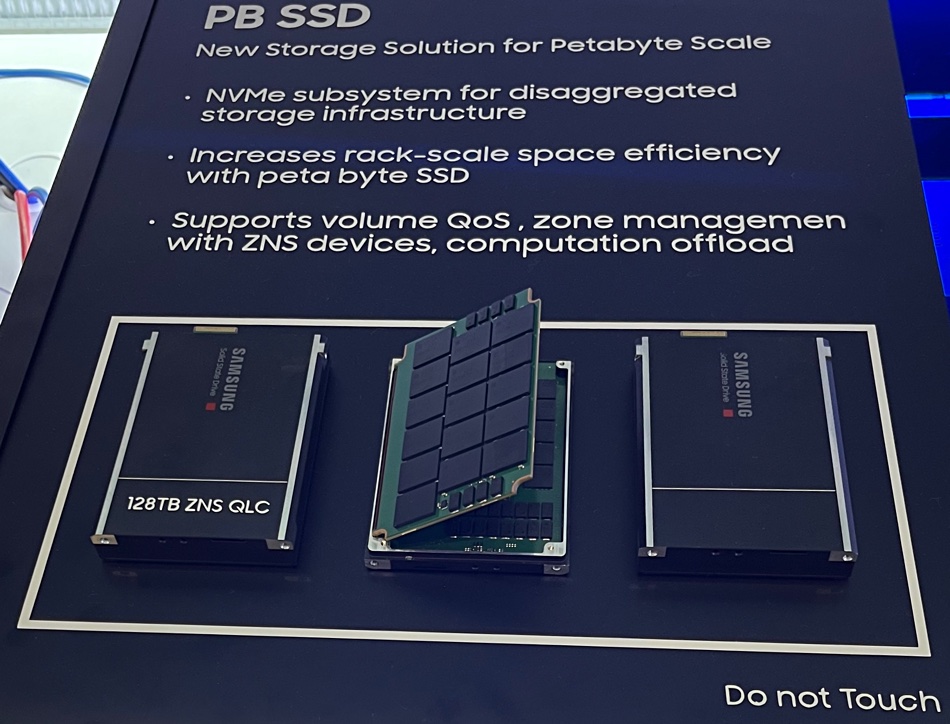
Samsung presents it as being capable of computational storage. The zoning means it can support different quality of service standards for zones, as set up by a host.
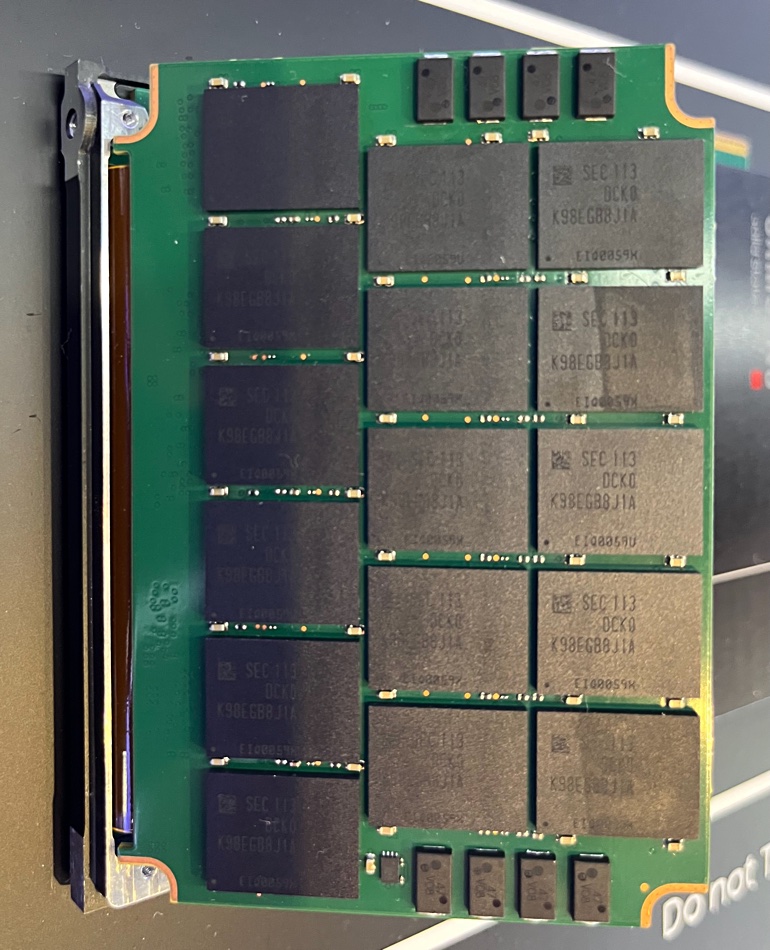
The 128TB capacity is four times that of today’s largest SSDs which top out at 30.7 or so terabytes. Nimbus sold a 100TB SSD back in March 2018. Toshiba, in pre-Kioxia-split days, and in the same month suggested it could build an 85TB SSD. We don’t recall this coming to the market.
Samsung’s announcement claimed the drive would “allow a single server unit to pack more than one petabyte of storage, enabling server manufacturers to sharply increase their storage capacity within the same floor space with a minimal number of servers. High server utilization will also help to lower power consumption.” Indeed.
Back-of-the-envelope math says a 2U x 24-slot chassis filled with Samsung’s 128TB drives would give you 3.07PB of capacity. Fill a rack with 20 of these enclosures and you get 61.4PB. Compression and deduplication could push the effective capacity past 100PB. These numbers are nuts. For even more mental pleasure allow yourself the prospect of such drives using penta-level cell (5bits/cell) flash and with 25 percent more capacity.
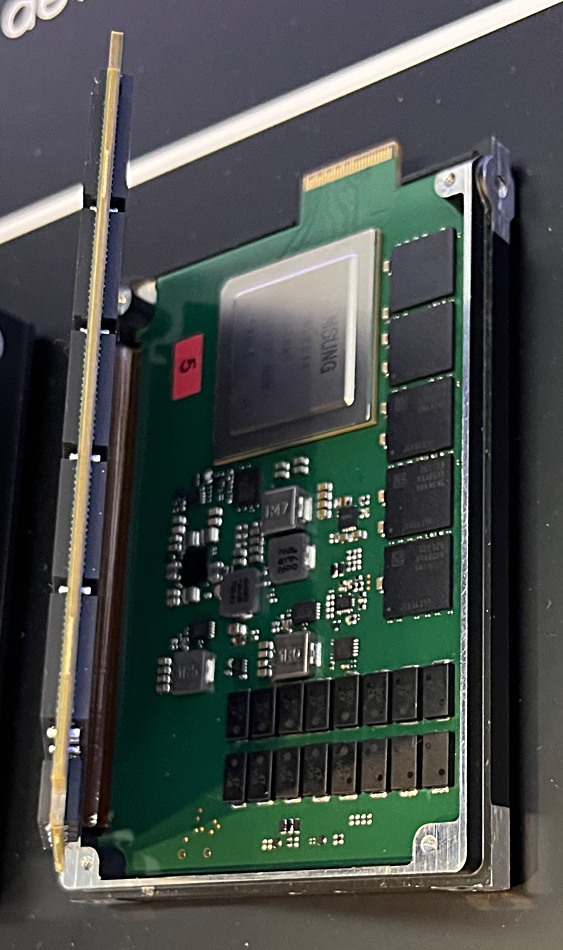
Memory-Semantic SSD
This is a hybrid DRAM and NAND drive supporting PCIe 5 and CXL connectivity with the DRAM providing a cache – 8GB in a canned rolling presentation – which is addressed with load-store memory semantic commands. This gives it superfast speed with a 20x improvement, according to Samsung, in 128 bytes random read IO performance and latency over a PCIe 4 SSD. The drive is targeting AI and machine learning apps that need fast processing of smaller data sets, and real-time RecSys inference application requirements can be met.

The DRAM is a data landing zone and Samsung’s controller copies the data to the NAND. The concept here is to provide equivalent capacity to an all-DRAM config similar performance through the caching but at much lower cost than a DRAM-only set up. It has a minimum 64 bytes data transfer base compared to NAND’s 4KB – according to a Samsung slide.
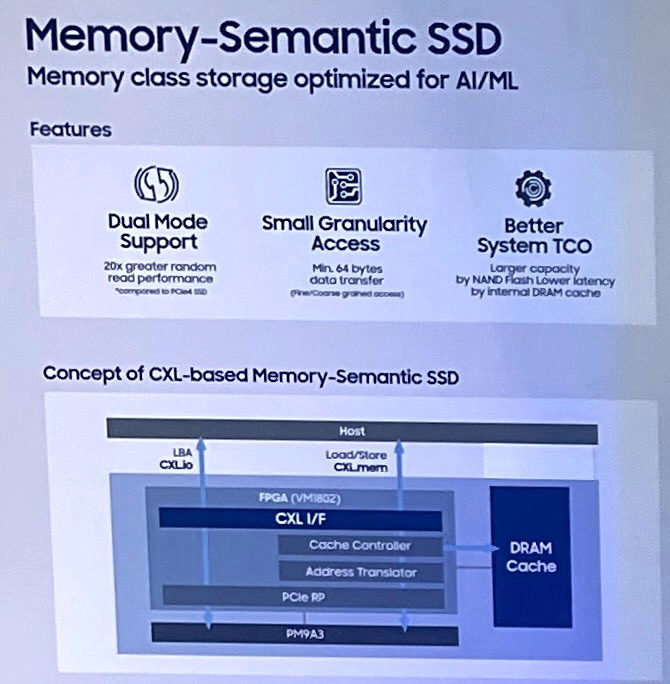
A booth display diagram indicated that the NAND portion of this drive is Samsung’s PM9A3 – an enterprise PCIe 4 interface SSD. That means the NAND part of this Memory-Semantic Drive provides from 960GB though 1.92TB, 3.84TB, 7.68TB, and 15.36TB of capacity using 128-layer 3D NAND in TLC format. The NAND performance is up to 1,100,000/200,000 random read/write IOPS and 6.95/4.1 GB/sec sequential read/write bandwidth.
So the Memory-Semantic drive is the innards of a PM9A3 front-ended by a CXL interface controller device with a side order of DRAM cache.
Now let’s hit the back of our envelope again and apply the 20x improvement in random read I/O, implying this Memory Semantic drive can hit up to 139GB/sec sequential read bandwidth or 22 million random read IOPS – it depends what Sammy means by random read I/O. Both are hugely impressive numbers.
The dual-mode interface means it be accessed as a NAND SSD with file-based NVME access or as a DRAM with load/store access for memory-mapped files.
A cutaway server showed the drive mounted inside its chassis and it’s obviously not a standard drive format like U.3/2 or one of the EDSFF ones:
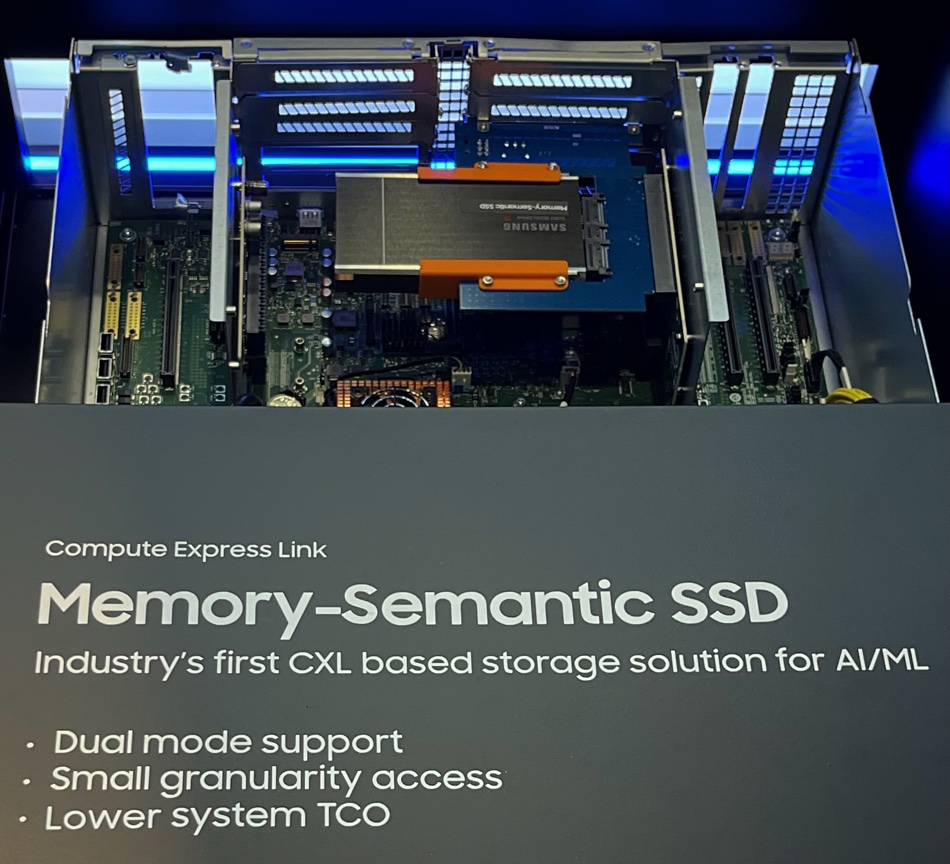
We think this should viewed as a prototype drive needing to be sold as a dedicated AI/ML system by a skilled integrator or OEM.
But there’s one more thought: This drive has a CXL load/store interface, is persistent, and is 20x faster than a PCIe 4 SSD. Surely that makes it a candidate for storage-class memory status?
SmartSSD
Sammy’s booth display included a gen-2 SmartSSD, with a PCIe 4×4 interface, AMD Versal FPGA with Arm processor and hardware accelerators, E3 form factor and TP4091(NVMe)/SNIA standardization.
This is a computational storage drive and succeeds the gen-1 version with its PCIe 3 interface and Kintex Ultra FPGA, all in a U.2 form factor. The gen-2 drive case and its printed circuit board look like this:

Telemetry and more
Samsung said it had instrumented its SSD’s NAND, DRAM, controllers and firmware. It has telemetry which provides human-readable metadata about the drive components’ status. This means, Sammy says, datacenters can detect and prevent any potential problems ahead of time.
The company also said that its May-announced UFS 4.0 mobile storage flash for smartphones will enter mass production this month. Two enterprise SSDs are now generally available: the PM1743 PCIe 5 drive and the 24GB SAS PM1653 SSD.








